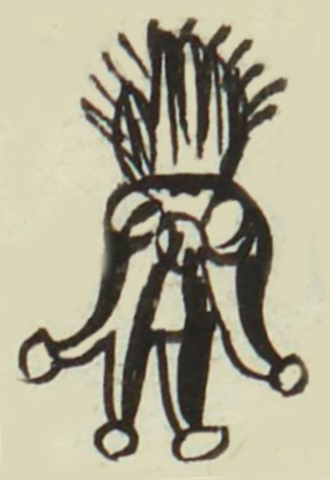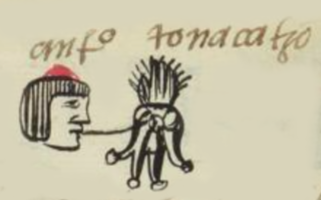Tonacaztzon (MH880r)
This black-line drawing of the simplex glyph for the personal name Tonacatzon (perhaps “Old People”) is attested here as a man’s name. The glyph shows perhaps a vertical clump of hair (tzontli, providing the phonetic suffix -tzon) with some rays of what may be sunshine (tona, at the start of the name) coming off the top. Below this ensemble are four short streams of water, two-toned black and white, with a droplet at the bottom of each one. The water underscores one of the -a- sounds in Tonaca-.
Stephanie Wood
Given that no old or dastardly people are shown in this compound, it seems fairly likely that the visual elements all contribute phonetic indicators. But perhaps there is another translation for Tonacatzon. The gloss does not include the final -n that is presumed to have been intended.
Stephanie Wood
anto tonacatzo
Antonio Tonacatzon
Stephanie Wood
1560
Jeff Haskett-Wood
pelo, cabello, rayos de sol, agua, viejos, nombres de hombres

tonacatzon, the old people or the dastardly ones, https://nahuatl.wired-humanities.org/content/tonacatzon
Viejos
Stephanie Wood
Matrícula de Huexotzinco, folio 880r, World Digital Library, https://www.loc.gov/resource/gdcwdl.wdl_15282/?sp=832&st=image
This manuscript is hosted by the Library of Congress and the World Digital Library; used here with the Creative Commons, “Attribution-NonCommercial-ShareAlike 3.0 License” (CC-BY-NC-SAq 3.0).



